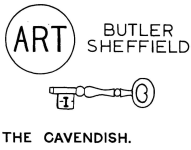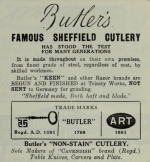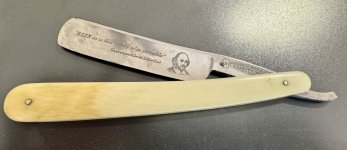I found an article on the history of George Butler, thought it would be worth sharing for those interested. I did not write or add any info to this, it is from a history of Sheffield makers.
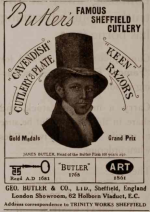
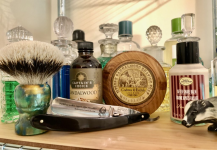
George Butler & Co.
This firm was a prominent maker of high-quality pocket knives, razors, scissors, and table cutlery. Its history is partly obscured by the lack of surviving business records, but Butler's appeared first at 4 Trinity Street on a hill between Furnace Hill and Gibraltar Street. The owner was William Butler, a pen and pocket knife cutler, who was recorded in directories in 1774, 1787, 1797, and 1811. His 'BUTLER' mark had been granted in 1768. William's history is mostly unknown: however, a Freedom was granted by the Company of Cutlers to a William Butler in 1768. He was the son of John Butler, a badger (hawker), and had been apprenticed to Jonathan Crooks (perhaps Jonathan Crookes) for seven years. Apparently, William had three sons - William (c.1777-1861), George (1780-1833), and James (c.1786-1843). William Butler Jun became a scissors manufacturer. James may be the cutler listed in Leader (1905-06), who was apprenticed to his father in 1800 and granted his Freedom in 1808. Leader (1876) stated that Butler's was the largest employer in the cutlery trade between 1810 and 1814. The founder presumably died in this period, because by 1816 the business had become George & James Butler, Trinity Works, Trinity Street.
By the 1820s, G. & J. Butler was selling 'all kinds of Sheffield hardware', including table, pen, pocket, sportsman's, and garden pruning knives, fleams, and lancets. It had some of the best and longest-serving workers in the trade (Charles Vaughan and William Crookes). George was the salesman and was described as an expert with the 'ribbons', driving tandem through the North of England and elsewhere on the firm's business. He lived at Upperthorpe. He died there on 5 May 1833, aged 53, and was buried in St George's churchyard, Portobello. George's executor and trustee was Rotherham merchant James Hodgson, who became James Butler's new partner. George's eldest son, William Charles Butler (22 July 1812-1837), was evidently being groomed to take his father's place. James also had a son, James Jun., who became briefly a partner in Butler's. By 1837, James Sen. and James Jun. also operated James Butler & Co, spade, shovel, edge tool manufacturers, and steel converters in Pond Hill.
In the 1840s, however, the Butler connection with the business waned. First, William Charles Butler died on 16 January 1837, aged 25 (he was buried in Portobello). In 1839, James Butler Jun. withdrew from the business (possibly he died, too). Then the senior partner James Butler, Western Bank, died on 3 March 1843, aged 57, and was buried in St. Paul's graveyard. Joseph Wolstenholme was executor and trustee. Later Butler advertisements carried a portrait of James Butler as a trade mark (dated 1916). However, the company now became George Butler & Co, because apparently only one family member remained: this was George Butler (another son of George Sen.). He died on 29 September 1850 (aged 29) and was buried in Ecclesall.
A new chapter in the company's history had already begun. In the late 1840s, William Henry Andrew (1820-1894) and Albert George Andrew (1820-1908) had become partners. They were the twin sons of Joseph Andrew, who was a prosperous grocer and tallow chandler in Furnace Hill and West Bar. They became 'successors' to the Butlers. The scope of the firm's products was widened - albeit temporarily - and an 1849 advertisement described the company as a steel converter and refiner, in addition to selling cutlery and tools. In about 1850, the Andrews brothers (who were apparently bachelors) recruited another partner. This was Henry George Rowe (c.1817-1868), who had been born in Durham, and was a traveller. In 1853, Rowe and the Andrews patented an improved method of fastening handles to table knives and forks. In that year, the firm also displayed its cutlery at the New York Exhibition.
The company relied upon the 'BUTLER' mark, but this was so often counterfeited that in 1861 Butler's acquired the 'ART' mark. In that year, the Census noted that, although Butler's usual workforce was 60, only about 14 were working (perhaps reflecting the slump in the American trade). In 1864, Butler's moved from Trinity Street to a larger works at 105 Eyre Street - once the location of Corsan, Denton & Burdekin. The name Trinity Works was retained. Henry George Rowe died, aged 51, on 7 October 1868 at Grange, Lancaster. He left £1,500. His replacement was Robert Belfitt (1842-1930), who had been born at Whittington, in Derbyshire, the son of William Belfitt (a butcher), and his wife, Charlotte. After working as a clerk at an iron founder, Belfitt moved to Butler's in 1870 and became managing director. At that time (according to A.G. Andrew), the firm employed about 50 men. In 1883, Butler's adopted limited liability, with a capital of £35,000. Belfitt became chairman and the Andrews retired. In 1896, Belfitt also became a director at James Dewsnap. William Henry Andrew died on 9 October 1894, aged 74, and was buried in the General Cemetery. Albert George Andrew died on 16 February 1908, aged 87, leaving £2,245 net (and was buried in an unconsecrated grave in the General Cemetery).
Belfitt maintained Butler's reputation for its hand-forged, hand-ground pocket and table cutlery both at home and in its major overseas markets in Australia and India. Butler's won prize medals at several exhibitions. The firm also expanded into electro-plate and table cutlery. In about 1882, Butler's acquired the Key mark (registered in 1681) from Steer & Webster; and silver marks were registered in 1872 and 1894. 'SPECIAL CAVENDISH BRAND' (granted 1885) was used on Butler's silver-plated table cutlery. The firm made high-quality cased goods. Sets of cutlery were produced for special occasions, including presentation sets for the Royal Family, and various dukes and archbishops. Butler's razors were popular. Its 'Keen' razor was described in the press as a 'distinctly special article': it was hollow-ground by the firm's own workmen, with the trade name derived from Shakespeare's Love's Labour's Lost: 'Keen as is the razor's edge invisible' - a line acid-etched on 'Keen' razors, alongside the Bard's head.
Trinity Works was one of the larger cutlery firms in Sheffield. In 1881, the workforce remained about 50 men, though the trade press claimed that it reached about 400 (The Industries of Sheffield: Business Review, 1888). Noted one reporter: 'The manufacture of table and pocket-knives, razors, scissors, electro-plate, fish carvers, fish-eaters, plated desserts, spoons and forks, etc., is carried on in the various stages at Trinity Works, which are amongst the largest of the kind in Sheffield. The buildings are four storeys, forming a square, and fitted with all modern improvements in machinery' (Sheffield & Rotherham Illustrated, 1897). In the 1890s, the firm had a London office at 60 Holborn Viaduct (Joseph Rodgers, were at 62). On the other hand, its fortunes seem to have dipped and in 1898 the capital of Butler's was reduced from £50,000 to £35,000.
In the interwar period, directories listed Butler's as mainly a table knife manufacturer, though a trade catalogue (dated 1939 and in the author's possession) shows that the firm still sold a wide range of hand-forged pocket-knives and scissors, razors, silver plated desserts, stainless table knives and luxury cased tableware. In about 1932, Butler's acquired the marks of Francis Newton & Sons, and thereafter listed that company at Trinity Works, Eyre Street. Butler's also acquired the Ashberry name. By then, the firm was under new management. In the 1920s, Smelter Joseph Young (1869-1954) became Butler's chairman (he was the founder and chairman of Tempered Spring Co). Another director was Robert Greaves Blake, who was linked with Thomas Turton, Sheaf Works, and Stephenson, Blake, the type founders (William Greaves & Son). Robert Belfitt had died at Lawson Road on 16 June 1930, leaving £29,479. His standing within the local cutlery elite (he was a Conservative, Churchman, magistrate, and had been Master Cutler in 1891) ensured a good attendance at his funeral in Ecclesall graveyard.
By the 1940s, the director of Butler's was William Raymond Shirecliffe Stephenson (1898-1977), who was the son of Sir Henry K. Stephenson (also of Stephenson, Blake). In 1949, W.R.S. Stephenson became Master Cutler. However, after the Second World War Butler's had difficulty in adapting to the mass market and was eventually liquidated in 1952. The assets were sold for £3,500 to Sidney Leppington, who acquired the Butler name and workforce (with the Ashberry mark passing to Lewis Rose; and Newton's marks to Hiram Wild). The Butler interests were sold, in turn, to a number of firms Ingersoll, Heron, and Coloroll - before being bought for £1 million by the French cutlery conglomerate Guy Degrenne, which used the Butler name from a factory in Ecclesfield. In 1993, Arthur Price bought the Butler brand to use on table cutlery.
@luv2shave this may be relevant.
Who else owns one? Share your photos!


George Butler & Co.
This firm was a prominent maker of high-quality pocket knives, razors, scissors, and table cutlery. Its history is partly obscured by the lack of surviving business records, but Butler's appeared first at 4 Trinity Street on a hill between Furnace Hill and Gibraltar Street. The owner was William Butler, a pen and pocket knife cutler, who was recorded in directories in 1774, 1787, 1797, and 1811. His 'BUTLER' mark had been granted in 1768. William's history is mostly unknown: however, a Freedom was granted by the Company of Cutlers to a William Butler in 1768. He was the son of John Butler, a badger (hawker), and had been apprenticed to Jonathan Crooks (perhaps Jonathan Crookes) for seven years. Apparently, William had three sons - William (c.1777-1861), George (1780-1833), and James (c.1786-1843). William Butler Jun became a scissors manufacturer. James may be the cutler listed in Leader (1905-06), who was apprenticed to his father in 1800 and granted his Freedom in 1808. Leader (1876) stated that Butler's was the largest employer in the cutlery trade between 1810 and 1814. The founder presumably died in this period, because by 1816 the business had become George & James Butler, Trinity Works, Trinity Street.
By the 1820s, G. & J. Butler was selling 'all kinds of Sheffield hardware', including table, pen, pocket, sportsman's, and garden pruning knives, fleams, and lancets. It had some of the best and longest-serving workers in the trade (Charles Vaughan and William Crookes). George was the salesman and was described as an expert with the 'ribbons', driving tandem through the North of England and elsewhere on the firm's business. He lived at Upperthorpe. He died there on 5 May 1833, aged 53, and was buried in St George's churchyard, Portobello. George's executor and trustee was Rotherham merchant James Hodgson, who became James Butler's new partner. George's eldest son, William Charles Butler (22 July 1812-1837), was evidently being groomed to take his father's place. James also had a son, James Jun., who became briefly a partner in Butler's. By 1837, James Sen. and James Jun. also operated James Butler & Co, spade, shovel, edge tool manufacturers, and steel converters in Pond Hill.
In the 1840s, however, the Butler connection with the business waned. First, William Charles Butler died on 16 January 1837, aged 25 (he was buried in Portobello). In 1839, James Butler Jun. withdrew from the business (possibly he died, too). Then the senior partner James Butler, Western Bank, died on 3 March 1843, aged 57, and was buried in St. Paul's graveyard. Joseph Wolstenholme was executor and trustee. Later Butler advertisements carried a portrait of James Butler as a trade mark (dated 1916). However, the company now became George Butler & Co, because apparently only one family member remained: this was George Butler (another son of George Sen.). He died on 29 September 1850 (aged 29) and was buried in Ecclesall.
A new chapter in the company's history had already begun. In the late 1840s, William Henry Andrew (1820-1894) and Albert George Andrew (1820-1908) had become partners. They were the twin sons of Joseph Andrew, who was a prosperous grocer and tallow chandler in Furnace Hill and West Bar. They became 'successors' to the Butlers. The scope of the firm's products was widened - albeit temporarily - and an 1849 advertisement described the company as a steel converter and refiner, in addition to selling cutlery and tools. In about 1850, the Andrews brothers (who were apparently bachelors) recruited another partner. This was Henry George Rowe (c.1817-1868), who had been born in Durham, and was a traveller. In 1853, Rowe and the Andrews patented an improved method of fastening handles to table knives and forks. In that year, the firm also displayed its cutlery at the New York Exhibition.
The company relied upon the 'BUTLER' mark, but this was so often counterfeited that in 1861 Butler's acquired the 'ART' mark. In that year, the Census noted that, although Butler's usual workforce was 60, only about 14 were working (perhaps reflecting the slump in the American trade). In 1864, Butler's moved from Trinity Street to a larger works at 105 Eyre Street - once the location of Corsan, Denton & Burdekin. The name Trinity Works was retained. Henry George Rowe died, aged 51, on 7 October 1868 at Grange, Lancaster. He left £1,500. His replacement was Robert Belfitt (1842-1930), who had been born at Whittington, in Derbyshire, the son of William Belfitt (a butcher), and his wife, Charlotte. After working as a clerk at an iron founder, Belfitt moved to Butler's in 1870 and became managing director. At that time (according to A.G. Andrew), the firm employed about 50 men. In 1883, Butler's adopted limited liability, with a capital of £35,000. Belfitt became chairman and the Andrews retired. In 1896, Belfitt also became a director at James Dewsnap. William Henry Andrew died on 9 October 1894, aged 74, and was buried in the General Cemetery. Albert George Andrew died on 16 February 1908, aged 87, leaving £2,245 net (and was buried in an unconsecrated grave in the General Cemetery).
Belfitt maintained Butler's reputation for its hand-forged, hand-ground pocket and table cutlery both at home and in its major overseas markets in Australia and India. Butler's won prize medals at several exhibitions. The firm also expanded into electro-plate and table cutlery. In about 1882, Butler's acquired the Key mark (registered in 1681) from Steer & Webster; and silver marks were registered in 1872 and 1894. 'SPECIAL CAVENDISH BRAND' (granted 1885) was used on Butler's silver-plated table cutlery. The firm made high-quality cased goods. Sets of cutlery were produced for special occasions, including presentation sets for the Royal Family, and various dukes and archbishops. Butler's razors were popular. Its 'Keen' razor was described in the press as a 'distinctly special article': it was hollow-ground by the firm's own workmen, with the trade name derived from Shakespeare's Love's Labour's Lost: 'Keen as is the razor's edge invisible' - a line acid-etched on 'Keen' razors, alongside the Bard's head.
Trinity Works was one of the larger cutlery firms in Sheffield. In 1881, the workforce remained about 50 men, though the trade press claimed that it reached about 400 (The Industries of Sheffield: Business Review, 1888). Noted one reporter: 'The manufacture of table and pocket-knives, razors, scissors, electro-plate, fish carvers, fish-eaters, plated desserts, spoons and forks, etc., is carried on in the various stages at Trinity Works, which are amongst the largest of the kind in Sheffield. The buildings are four storeys, forming a square, and fitted with all modern improvements in machinery' (Sheffield & Rotherham Illustrated, 1897). In the 1890s, the firm had a London office at 60 Holborn Viaduct (Joseph Rodgers, were at 62). On the other hand, its fortunes seem to have dipped and in 1898 the capital of Butler's was reduced from £50,000 to £35,000.
In the interwar period, directories listed Butler's as mainly a table knife manufacturer, though a trade catalogue (dated 1939 and in the author's possession) shows that the firm still sold a wide range of hand-forged pocket-knives and scissors, razors, silver plated desserts, stainless table knives and luxury cased tableware. In about 1932, Butler's acquired the marks of Francis Newton & Sons, and thereafter listed that company at Trinity Works, Eyre Street. Butler's also acquired the Ashberry name. By then, the firm was under new management. In the 1920s, Smelter Joseph Young (1869-1954) became Butler's chairman (he was the founder and chairman of Tempered Spring Co). Another director was Robert Greaves Blake, who was linked with Thomas Turton, Sheaf Works, and Stephenson, Blake, the type founders (William Greaves & Son). Robert Belfitt had died at Lawson Road on 16 June 1930, leaving £29,479. His standing within the local cutlery elite (he was a Conservative, Churchman, magistrate, and had been Master Cutler in 1891) ensured a good attendance at his funeral in Ecclesall graveyard.
By the 1940s, the director of Butler's was William Raymond Shirecliffe Stephenson (1898-1977), who was the son of Sir Henry K. Stephenson (also of Stephenson, Blake). In 1949, W.R.S. Stephenson became Master Cutler. However, after the Second World War Butler's had difficulty in adapting to the mass market and was eventually liquidated in 1952. The assets were sold for £3,500 to Sidney Leppington, who acquired the Butler name and workforce (with the Ashberry mark passing to Lewis Rose; and Newton's marks to Hiram Wild). The Butler interests were sold, in turn, to a number of firms Ingersoll, Heron, and Coloroll - before being bought for £1 million by the French cutlery conglomerate Guy Degrenne, which used the Butler name from a factory in Ecclesfield. In 1993, Arthur Price bought the Butler brand to use on table cutlery.
@luv2shave this may be relevant.
Who else owns one? Share your photos!

